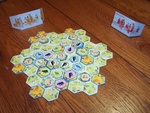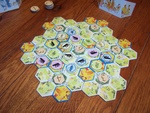
|
Palatinus A game by Alessandro Zucchini Published by da Vinci Games and distributed in the US by Mayfair Games, Inc. Players: 2-5 Time: 20 minutes Reviewed by Susan Rozmiarek |

|
Palatinus, The Seven Hills of Rome, is a new game by Alessandro Zucchini, who also designed the card game Luccà Citta, also published recently by Mayfair and daVinci Games. In Palatinus, players are trying to gain control of the Seven Hills by careful placement of inhabitants. The game utilizes a mostly hidden tile-laying mechanism and an unusual scoring mechanism to determine area control.
Components:
- 7 territory tiles - the tiles are lettered A through G and each consists of a central "hill" hex surrounded by six other hexes that represent either fields or springs.
- 7 laurel tokens, each has a number 3, 4, 5 or 6 on it
- 12 scoring discs, each with either a number 1 or 2 on it
- 5 player screens - on the back of each screen is a track that is used to keep track of the scoring at the end of the game.
- 5 wooden scoring cubes
- 60 inhabitant tokens - 12 each in five player colors. Each player set contains tokens that represent farmers, soldiers or merchants. Some are double-sided, while others have a wolf on the back. Soldier tokens are all double-sided.
- 1 linen bag
- Rules - the rules are four pages long with color illustrations and examples. The rules do a fairly good job of explaining the fairly confusing scoring in this game.
Game play:
While the actual play of the game is simple, the scoring at the end is initially very confusing. Players need to play a "learning" game and see how the scoring works before expecting to understand the game at all.
To set up the game, one territory tile is randomly chosen and placed in the center of the table. The laurel token numbered six is paced on the center hill space. This is the Palatinus hill. In clockwise order, players draw a territory tile from those remaining and place it around the Palatinus hill until all have been placed. A board of hexagonal spaces in roughly the shape of a circle will be the result. The remaining laurel tokens are randomly placed, one on each of the territory tiles. The number on each laurel token represents that hill's value. Players take their inhabitant tokens and hide them behind their player screens. The number of tokens used is adjusted for the number of players in a way that once all players have placed all their tokens, there will only be a few empty spaces left on the board. The game is now ready to begin.
The game play is very simple. Players take turns in clockwise order placing one of their tokens on an empty space on the board. If the token placed has a wolf on the back, it is placed with the wolf side up so that the other players cannot see what type of inhabitant it is. The only restriction is that a player's soldiers must be placed before the last three turns of the game. Note that soldiers are all double-sided and so are placed openly. Once all the players have placed all their inhabitants, the game is over and all the tokens are revealed and each hill is scored.The scoring is the tricky part and is very difficult to explain. Each territory tile/hill is evaluated in alphabetical order beginning with the "A" tile. Each inhabitant on each of the six hexes surrounding that hill is evaluated, one at a time. The soldiers are evaluated first, and then the others are evaluated for influence to determine who controls that hill in the following manner:
Soldiers: All the soldiers surrounding that hill are resolved at the same time. For each soldier surrounding the hill, you count the number of merchants and farmers in each of the hexes around that soldier, regardless of the inhabitant's color or what territory tile they are on. If the number of farmers equals the number of merchants, the soldier retreats and is removed from the board. If the number of merchants is different than the number of farmers, the soldier captures the larger group. He takes the captured inhabitant tokens off the board and they will each be worth one point. Soldiers do not have any effect on each other, but can share in the captures. If more than one soldier captures an inhabitant, one player gets the inhabitant token and the other(s) get a one-point scoring disc.
Now merchants and farmers are evaluated to see who controls the hill. Players lay their player shields flat and use the scoring track and wooden scoring cube to help them add up their influence for each hill. Each merchant and farmer around the hill scores influence points in the following manner:
Merchants: Each merchant gets influence points for each inhabitant adjacent to it regardless of color or the territory tile on which it is standing - 1 point for each merchant, 2 points for each farmer, and 3 points for each soldier.
Farmers: Each farmer gets 2 points for each adjacent unoccupied field and 2 points for each adjacent spring (occupied or not), and 2 points if he is standing on a spring.
The player with the most influence on each hill gets the laurel token. If more than one player ties, the laurel token is discarded and the tying player(s) get two-point discs instead.
After all the hills have been scored, players add up their captured inhabitants, scoring discs, and laurel tokens. The player with the highest total is the winner.
Despite the hidden information, there are a few strategies that one can employ. It is easy to spot and grab the most valuable locations for farmers based on the springs. Soldiers can be placed on locations that are surrounded by an odd number of hexes, thus making it more likely to capture surrounding inhabitants. However, another player can also thwart this by placing a soldier on one of those spots, making the number even. Still, it is VERY difficult to predict how placements will work out as tokens may be removed as each hill is evaluated, affecting the scoring of subsequent hills.
Comments:
Though Palatinus is elegant with some clever ideas, in the end I found it to be too much mental work to be enjoyable. It is possible to play in such a way as to make it a lighter game, but I did not find this to be very satisfying. It plays very quickly, however, and scales well with differing numbers of players. It does feel very original and I suspect that there are some who are going to enjoy the depth that it offers in such a short playing time. However, I definitely feel that this is a game that one needs to try before purchasing.
| Other Web information: |
This page viewed
E-mail Ed Rozmiarek with questions or problems concerning this page.
Copyright © 2006, Ed & Susan Rozmiarek. No portion of this website may be reproduced or copied without the consent of Ed or Susan Rozmiarek.



